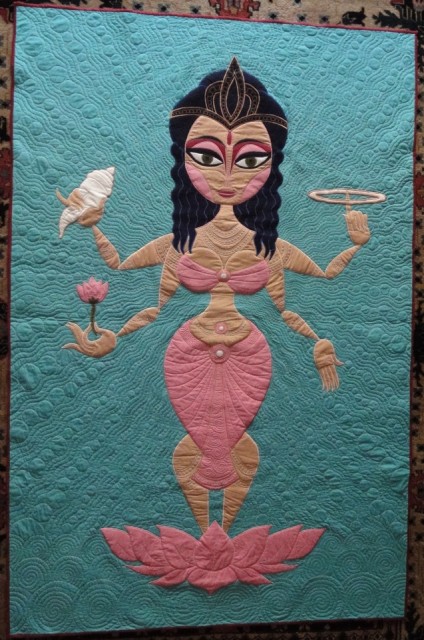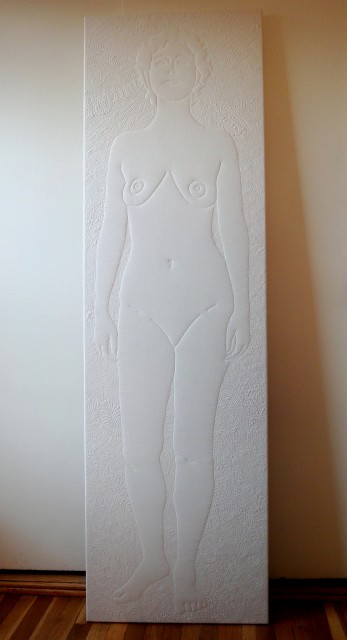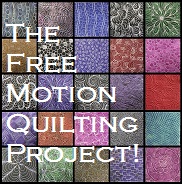Looks like I will be in Berlin for the Open Knowledge Conference June 30-July 1. If anyone wants me to speak/workshop/do a presentation in Berlin around that time, please contact me ASAP so I can plan my dates while plane tickets are still on sale I will be available July 2nd, going home July 3rd. Super speaking discount if you don’t have to pay for travel! (My usual exorbitant rates are here.)
Laxmi Devi quilt
Here’s what I’ve been working on the past couple weeks:
 Yep that’s “Laxmi” from Sita Sings the Blues. Cotton fabric, polyester batting, polyester thread. 52″ wide by 72″ high – twice as big as any of my 4 Elements panels. I might sew some shiny gold sequin things coming out of Her open hand to symbolize the gold coins that are often shown pouring out of it. Continue reading “Laxmi Devi quilt”
Yep that’s “Laxmi” from Sita Sings the Blues. Cotton fabric, polyester batting, polyester thread. 52″ wide by 72″ high – twice as big as any of my 4 Elements panels. I might sew some shiny gold sequin things coming out of Her open hand to symbolize the gold coins that are often shown pouring out of it. Continue reading “Laxmi Devi quilt”
Yes Means Yes
Please don’t ask my permission to re-use my work. YOU ALREADY HAVE PERMISSION. Please copy, share, re-use, redistribute, edit, modify, sell, etc.
Asking permission wastes your time, and mine. You might not mind wasting your time. Many people think asking for permission is a “sign of respect.” But what about my time?
Information (including all of my work) is not scarce. Attention (time) is.
Emails get lost in spam filters. They get lost amid the hundreds of other emails in my inbox. I’ve been known to take vacations and actually get away from my computer for a few days – something I should be doing more often. So what happens if you don’t get any response to your permission request? Do you not reuse the work? A work that has been explicitly made Free in the hopes you will reuse it? Not reusing the work harms the work, and harming a work is disrespectful. Delaying reusing the work likewise harms the work, in smaller increments.
Suppose a “respectful” email asking for permission which has already been explicitly granted doesn’t get caught in a spam filter or lost in some other glitch. Suppose it actualy makes it into my inbox. Now I am obligated to respond – the requester essentially said, “I’m not going to use this work unless you respond.” As “respectful” as this sounds, it places an unfair burden on me. The work, and any use of the work, should not be held hostage pending my checking and responding to email.
It is not “respectful” to make me do more, unnecessary work.
More importantly, asking permission is bad for the work itself. If you refuse to reuse the work unless I send you an email, you are blocking an expression or distribution of the work. How many days or weeks or months are you willing to put it off pending my ability to process email? Or worse, someone thinks it’s “respectful” to require me to sign papers and mail them back. Yes, this happens. I have such paperwork sitting right here, telling me that unless I sign it and mail it back, they won’t use the work they already have explicit permission to use. How is it “respectful” to make me jump through more hoops before they redistribute or remix a work I’ve made explicitly Free?
If you want to show respect, please send me something like this instead:
Dear Nina,
I thought you might like to know I’ve reused _________________ in _________________. Check it out at (insert URL here). Thanks for making the work Free!
Love,
Someone Who Understands Yes means Yes
Ahh, lovely. Thank you!
A complaint I hear often is that nowadays thanks to the inerwebs, not only do artists “have to give their work away for free” but they also “have to be businessmen.” HA! One goal of freeing my work is to free me of paperwork, contracts, and the role of manager – and what is having to oversee and administrate every re-use but management? In the “Intellectual Property” model, artists either have to do much more negotiating and managing and paperwork, or they have to pay someone else to do it for them. They have to be businessmen, or hire businessmen. And hiring businessmen (agents, lawyers, etc.) still requires much paperwork, negotiating, and contracts.
Some still insist that I’ve “maintained more control” over Sita Sings the Blues. The point is I have maintained no control over it, and that benefits me. The point is I don’t have to be a business(wo)man. The point is that other people, the crowd, distribute the work, and cost me nothing.
As long as they don’t ask for permission.
This is ART, bitches!
My latest quilt is Capital-A Art. Know why?
- It’s white on white
- It depicts a nude
- It is on canvas stretchers
Ladies and gentlemen, I unveil the fourth and final installment of my 4 Elements quilt series: Air/Nude!
 77″ x 23″ (yielding a life-size figure), unbleached cotton muslin, cotton batting, polyester thread.
77″ x 23″ (yielding a life-size figure), unbleached cotton muslin, cotton batting, polyester thread.
She counts as “Air” in the series because that’s what the model is wearing. Also, unless you look carefully you see nothing, just like air.
The photo above links to a super high res, 3,000-pixel-high version so you can zoom in on all the detail. Also check out these closeup shots (which link to 960-pixel-high versions): Continue reading “This is ART, bitches!”
A Wonderful Day
I’ve mentioned quilter Leah Day here before, and will mention her again. Leah “e”-teaches me and countless others how to Free Motion Quilt via her online Free Motion Quilting Project. I wrote about her refreshingly open attitude and progressive business model on Techdirt a few months ago. But I’m posting today to bring your attention to her new informational copyright page, which is so beautiful it almost brings a tear to my eye. This is how it’s done, people.
Reminder: Please Share Mimi & Eunice
Just a reminder to please please share, copy, email, post, re-post, link to, etc. my daily comic strip Mimi & Eunice. They’re competing against everything else on the interwebs for limited attention, and only you/me/us can help get them out there.
Here’s today’s, posted via the super-convenient “embed” code on every strip:

Obviously I’m offending at least as many people as are becoming fans, so it’s all the more important the fans share it.
Like everything I do, all Mimi & Eunice comics are Free for any use whatsoever. ♡ Copying is an act of love. Please copy & share.

